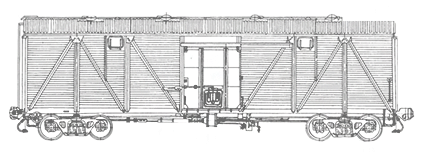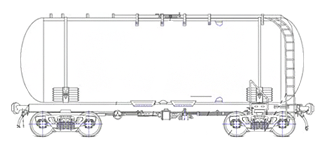Railway wagons
COVERED WAGON
4-axle covered wagon, model 11-066-04

A covered goods wagon or van is a railway goods wagon which is designed for the transportation of moisture-susceptible goods and therefore fully enclosed by sides and a fixed roof. They are often referred to simply as covered wagons, and this is the term used by the International Union of Railways (UIC). Since the introduction of the international classification for goods wagons by the UIC in the 1960s a distinction has been drawn between ordinary and special covered wagons. Other types of wagon, such as refrigerated vans and goods wagons with opening roofs, are closely related to covered wagons from a design point of view.
Similar freight cars in North America are boxcars
Covered goods wagons for transporting part-load or parcel goods are almost as old as the railway itself. Because part-load goods were the most common freight in the early days of the railway, the covered van was then the most important type of goods wagon and, for example, comprised about 40% of the German railways goods fleet until the 1960s. Since then however the open wagon and flat wagon have become more common. By contrast the covered goods wagon still forms the majority of two-axled wagons in countries like Germany, because the comparatively light freight does not routinely require the use of bogie wagons.
The formerly widespread ordinary covered wagon with side doors was almost fully displaced in the third quarter of the 20th century by special covered wagons with sliding walls which can be rapidly loaded and unloaded with palletised goods using fork-lift trucks.
A boxcar is a North American railroad car that is enclosed and generally used to carry general freight. The boxcar, while not the simplest freight cardesign, is probably the most versatile, since it can carry most loads. Boxcars have side doors of varying size and operation, and some include end doors and adjustable bulkheads to load very large items.
Similar covered freight cars outside North America are covered goods wagons and, depending on the region, are called "goods van" (UK), "louvre van" (Australia), "covered wagon" (UIC and UK) or just "van" (UIC and UK).
Payload: 68 tonnes
Unladen weight (min/max): 21.3/22 tonnes;
Length over the buffers: 14730 mm;
Length of a platform by the ends of the frame: 13870 mm;
Max width: 3279 mm;
Height from the level of the rails (max): 4700 mm;
Height from the level of the rails to the floor: 1283 mm;
Axles: 4;
Internal length of the car: 13500 mm;
Internal width of the car: 2760 mm;
Height alongside the wall: 2791 mm;
Door dimensions: 2000x2301 mm;
Wall hatch dimensions: 690x370 mm;
Roof hatch dimensions: 400x400 mm;
Volume (upto the hatches): 86,4 м3;
Volume (with the roof): 120,15 м3.
OPEN WAGON
4-axle modern open wagon, with unloading hatches in the floor and fixed sides, model 12-783. These wagons have a level floor and solid sides with at least one door on each side.

Open wagons form a large group of railway goods wagons designed primarily for the transportation of bulk goods that are not moisture-retentive and can usually be tipped, dumped or shovelled.
They are mainly used for transporting bulk goods, coal, scrap, steel, wood and paper. The majority of wagons have folding sides and end walls, otherwise they are given the letters l (fixed sides) or o (fixed end walls). Wagons may have one or two folding end walls. Steel rings enable ropes, nets or covers to be attached to secure the load.
Some of these wagons can also be completely tipped over, in other words, at certain places they can be lifted up and emptied by being turned about their longitudinal axis. This requires a very robust underframe. Sometimes the wagons are fitted with rotatable couplings so that they do not have to be individually uncoupled.
In Russia often used for transportation of containers when there is a lack of fitting platforms.
Square of the floor: 38 м2;
Payload: 70 tonnes;
Unladen weight (min/max): 23/24 tonnes;
Volume of the wagon: 78 м3;
Length over the buffers: 13920 mm;
Length of a platform by the ends of the frame: 12800 mm;
Max width: 3224 mm;
Height from the level of the rails (max): 3478 mm;
Height from the level of the rails to the floor: 1415 mm;
Axles: 4;
Internal width: 2964 mm;
Internal length: 12478 mm;
Internal height: 2045 mm;
Number of unloading hatches: 14;
Dimensions of unloading hatches: 1370x1540 mm;
Angle of doors opening: middle 31 degrees.
FLAT WAGON or PLATFORM
4-axle platform used for transportation of containers, wheeled and tracked or caterpillar vehicles, model 13-935A-04

Flat wagons (sometimes flat beds, flats or rail flats, US: flatcars), as classified by the International Union of Railways (UIC), are railway goods wagons that have a flat, usually full-length, deck (or 2 decks on car transporters) and little or no superstructure. By contrast, open wagons have high side and end walls and covered goods wagons have a fixed roof and sides. Flat wagons are often designed for the transportation of goods that are not weather-sensitive. Some flat wagons are able to be covered completely by tarpaulins or hoods and are therefore suitable for the transport of weather-sensitive goods. Unlike a "goods wagon with opening roof", the loading area of a flat is entirely open and accessible once the cover is removed.
Typical goods transported by these railway wagons are: vehicles, engines, large pipes, metal beams, wire coils, wire mesh, half-finished steel products, (sheets, coils, pipes, bars and plates), containers, rails, sleepers and complete sections of railway track. Gravel, sand and other bulk goods are transported on flat wagons with side panels.
Container wagons are flats specially fitted with securing equipment for transporting ISO containers. Most container flats are designed to take standard 20 and 40 foot ISO containers. Two-axle wagons of this type are able to carry two 20-foot or one 40-foot container; many four-axle wagons have room for three 20-foot or one 40-foot and one 20-foot container.
Payload: 69 tonnes;
Unladen weight: 25 tonnes;
Length over the buffers: 19620 mm;
Length of a platform by the ends of the frame: 18400 mm;
Max width: 3164 mm;
Height from the level of the rails (max): 1962 mm;
Height from the level of the rails (to the level of buffers): 1070 mm;
Height from the level of the rails (to the level of the floor): 1252 mm;
Axles: 4;
Height of end walls: 400 mm;
Number of folding fittings: 24;
Square of the floor: 54 м2.
TANK WAGON
4-axle tank wagons are designed to transport liquid and gaseous commodities, for example petroleum, models 15-1443-02

Volume: 72,2 м3;
Length over the buffers: 12020 mm;
Length of a platform by the ends of the frame: 10800 mm;
Max height from the level of the rails (to the level of the floor): 4615 mm;
Axles: 4;
Internal diameter of the tank: 3000 mm;
External length of the tank: 10770 mm;
Specific volume: 1,19 м3/tonn;
Number of top hatches: 1;
Method of loading and unloading: loading by pouring from the top - unloading by drain;
Number of exterior stairs: 2;
Number of interior stairs: 1;
Payload: 62 tonnes.